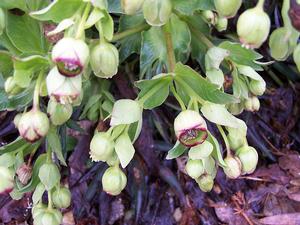View All Plants :: View All SHADE PERENNIALS
Helleborus foetidus
Bearclaw Hellebore
Plant Type:
SHADE PERENNIALSHelleborus foetidus – Bearclaw Hellebore. Round green buds hidden in pale green sheaths can begin to emerge in December in northeastern Connecticut. If the winter isn't too harsh the Granny Smith apple-green marbles open into bells. These can last the entire winter. If the weather is too harsh, temps too cold and dry for extended periods the plant may toast. This occurs only occasionally here in Zone 5b. Most winters the flowers last and are an absolute delight. Also known as the Stinking Hellebore – what a rotten name! - the flowers are apparently “fragrant” though I have never actually whiffed them. This trait probably varies from population to population. Each leaf is composed of narrow blades set in a palmate structure resembling a bear claw. Foliage is layered, broad, and dark vinyl on the thick stems. Flowers occur terminally at tops of stems. Ants love the fatty structure (elaiosomes) on the relatively large, heavy seeds. They carry these off to their colonies where they store the seeds until they eat the fatty deposit. They then dispose of the seeds usually a distance from the mother plant. This fascinating strategy allows Helleborus foetidus to extend its range as the seeds are too heavy generally to be carried by the wind. Interesting stuff, no? Will self sow with the help of the ants if happy. Fertile, draining soil in open to part shade. Nativity is Central and Western Europe. Seed grown.
Characteristics and Attributes for Helleborus foetidus
Season of Interest (Flowering)
- Winter / Spring
Season of Interest (Foliage)
- Four Seasons
Autumn Interest
- Showy Buds
Nature Attraction
- Deer Resistant
Light
- Dappled Shade
- Morning Sun / Afternoon Shade
- Shade
Attributes
- Natural Garden
- Drought Tolerant
- Bank
- Evergreen
- Massing
- Rock Garden
- Specimen
- Woodland
Growth Rate in the Garden
- Medium
Soil
- Fertile
- Draining
- Woodland
Origins
- Europe
Propagated By
- By Seed / Potted


